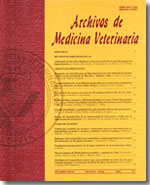Características de los bovinos faenados en la Xa Región (Chile) según las pautas indicadas en las normas oficiales de clasificación y tipificación
Contenido principal del artículo
Resumen
Se describió el sexo y la edad de 114.666 bovinos faenados en los 22 mataderos habilitados en la Xa Región durante 1994 y las características de sus canales, utilizando las pautas impuestas por las normas chilenas oficiales de clasificación del ganado bovino y tipificación de sus canales.
En cuanto a la clasificación de los bovinos, basada en la edad por cronometría dentaria (presencia de dientes de leche sin nivelar=DL , pinzas de leche niveladas=DL*, número de incisivos permanentes=2-8D, segundos medianos nivelados 8D*) y el sexo, se encontró que la distribución regional de clases fue: 40.3% Novillito (DL* ó 2D); 16.1% Vaquilla (DL* ó 2D); 1.5% Torito (DL*); 10.6% Novillo (4-6D); 7.6% Vaca joven (4-6D); 9.0% Vaca adulta (8D); 6.1% Vaca vieja (8D*); 0.0% Toruno (2-8D*); 2.4% Toro (2-8D*); 4.2% Buey (8D ó 8D*) y 2.2% Ternero/a (DL). Para las categorías de tipificación de las canales la distribución fue la siguiente: V=55.9%; A= 12.7%; C= 4,6%; U= 15.2%; N= 10.4% y O= 1.2%.
Los diferentes grados de cobertura grasa se presentaron en un 10.1% el grado 0 (prácticamente no existe), un 78.3% el grado 1 (escasa), un 10.2% el grado 2 (abundante) y un 1.4% el grado 3 (excesiva). Se registró un 7.7% de contusiones en el total de canales, de las cuales un 4.8% correspondió a contusiones de primer grado (afectan sólo tejido subcutáneo), un 2.1% de segundo grado (afectan también músculo) y un 0.8% de tercer grado (afectan incluso hueso) .
Se concluye que en la Xa Región predomina la faena de bovinos jóvenes, de hasta 2 dientes incisivos permanentes, especialmente novillitos y vaquillas, cuyas canales presentan una cobertura grasa escasa, siendo categorizadas en V. Además, las contusiones que afectan la categorización (grado 2 y 3) se presentan en un bajo porcentaje.

